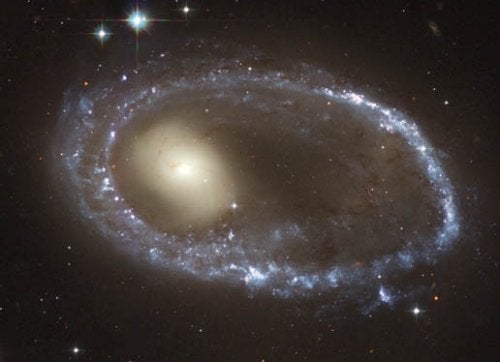Traditionally, a 14th-anniversary gift is an ivory product. No longer an ideal gift due to society’s reproach as to how the dentine is harvested, ivory has been replaced by gold. Ignoring either custom, the Space Telescope Science Institute has given us diamond-encrusted jewelry to commemorate Hubble’s 14th year in space.
Launched on April 24, 1990, the Hubble Space Telescope (HST) has captured many remarkably beautiful images. For its anniversary, it imaged blue star clusters wrapped around a galactic nucleus. Nearly 150,000 light-years in diameter — larger than the Milky Way — this ring galaxy is located 300 million light-years away from Earth in the direction of the constellation Dorado. Inside the bluish, sparkling circle is the center of what was once a spiral galaxy.
Ring galaxies occur when one galaxy stabs through the disk of another (the galaxy that intruded on this ring is out of this HST view). This type of impact can dramatically influence the structure of both galaxies and prompt new star formation. The collision generates a shock that alters the orbits of stars and gas in the disk of the pierced galaxy, thrusting them outward. As the ring moves into its surroundings, gas clouds collide. The compressed clouds then reduce under their own gravity, collapse, and develop new stars.
The rich color of this image is provided, in part, by the bluish color generated by newly formed, hot stars. Slight pinkish spots around the ring are billows of shining hydrogen gas illuminated thanks to strong ultraviolet light from the newly formed, massive stars.
This image was captured in January 2004 with Hubble’s Advanced Camera for
Surveys. The team used a combination of four separate filters that isolate blue, green, red, and near-infrared light to create the color image.










